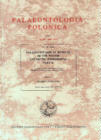| PALAEONTOLOGIA POLONICA VOL. 62 | ||
 |
Editor: Assistant editor: |
|
|
Andrzej
KAIM |
|
Abstract: Data
on embryonic, larval, and postlarval morphology of the gastropod conchs from the
Mid Jurassic to Early Cretaceous black clays from Poland are used to improve
their taxonomy. The phylogenetic relationships of the fossil gastropod taxa to
their Recent relatives are traced. The results show that most of the Recent
groups were already present in the Mid Jurassic. The vetigastropods are
apparently conservative and shells of some groups have not changed significantly
for at least 160 Ma. The most primitive extant caenogastropods (e.g.,
Cerithioidea and Ampullospiridae) most probably have originated from the
branches which diverged already in the Late Paleozoic. The other caenogastropods
have undergone significant radiation in the Triassic. Then the Caenogastropoda
had a period of relative stagnation. The significant exception is emergence and
rapid radiation of Neogastropoda during the Cretaceous. The most diversified
Mesozoic family of Heterostropha, the Mathildidae, had its acme from the Late
Triassic to the Early Cretaceous. Later the family gradually declines and
nowadays it is a relic group. The oldest cephalaspidean opisthobranchians are
known since the Early Triassic but the significant radiation has taken place in
the Mid Jurassic. The siphonariids, the marine pulmonates, are recognized from
the Early Cretaceous. 135 species (54 of them new) and two new genera (Dzikella
and Gnaszynium) are described. Key words:
Gastropoda,
evolution, phylogeny, taxonomy, Jurassic, Cretaceous, Poland. Andrzej
Kaim [kaim@twarda.pan.pl], Institute of Paleobiology, Polish Academy of Sciences,
Twarda 51/55, PL-00-818 Warszawa, Poland. |
|
Streszczenie: Ewolucja ontogenezy muszli u mezozoicznych ślimaków otwartego morza W pracy przedstawiono taksonomię jurajskich i kredowych
ślimaków Polski ze szczególnym uwzględnieniem cech muszli embrionalnych,
larwalnych oraz wczesnoontogenetycznych muszli postlarwalnych. Zbadano również
związki filogenetyczne pomiędzy ślimakami kopalnymi i ich współczesnymi
krewniakami. Rezultaty badań wykazały, że większość group taksonomicznych
wyższego rzędu była już obecna w środkowej jurze. Vetigastropody są ślimakami
konserwatywnymi i niektóre ich grupy nie zmieniły się znacząco od 160 milionów
lat. Najprymitywniejsze cenogastropody, tj. Cerithioidea i Ampullospiridae,
pojawiły się najprawdopodobniej już w późnym Paleozoiku. Inne
cenogastropody, które przeszły znaczącą radiację w Triasie, w późniejszym
czasie miały okres relatywnej stagnacji. Jedynym istotnym wyjątkiem jest
powstanie i szybka radiacja neogastropodów w kredzie. Silnie zróżnicowana w
Mezozoiku rodzina Mathildidae należąca do Heterostropha stopniowo zanika począwszy
od początku późnej kredy i współcześnie jest grupą reliktową. Najstarsze
cefalaspidowe tyłoskrzelne są znane od wczesnego triasu ale ich główna
radiacja miała miejsce w środkowej jurze. Sifonaridy, które są morskimi płucodysznymi
zostały rozpoznane już od wczesnej kredy. W pracy opisano 135 gatunków z których
54 to gatunki nowe oraz dwa nowe rodzaje (Dzikella
i Gnaszynium). |
|
Home | Editors | Current Issue | Archive | Instructions | Subscription | History | Institute of Paleobiologyy |
|
| ©
1997-2006. Instytut Paleobiologii PAN Web Site Design by Jarosław Stolarski Last updated 04-12-09 |
Best
viewed by Internet Exlorer 4.x or higher and |